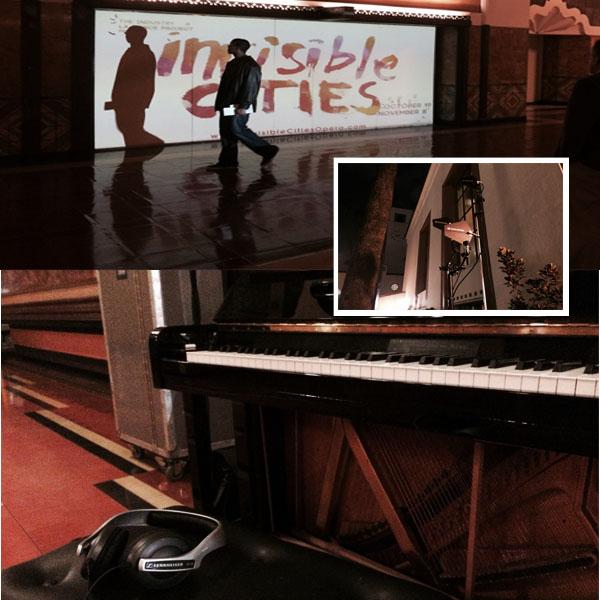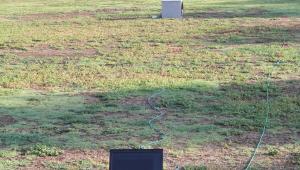Invisible Cities: The Seamless Meeting of Art and Technology

Invisible Cities is, first and foremost, an opera about a king, Kublai Khan, whose city is suffering from a “decay of excess” and an explorer, Marco Polo, who the king calls upon to assist him in finding the reason for the city’s decline, and the key to it’s future. The opera moves through several scenes where Marco Polo describes his travels, and Kublai Khan gains wisdom that enables him to find direction. That, in itself, is pretty intense stuff, and the score reflects this very well; shifting from broad and sweeping to haunting and delicate, bringing the listener along for the ride as Marco Polo describes city after city, each with it’s own musical flavor. The score and libretto are wonderfully crafted and hold up on their own. I mention this lest you think the experience I’m about to describe in any way gimmicky. In fact, the entire piece works because each aspect: the musicians, the performers, and the technology all were wielded with discretion, and only when it suited the larger whole.
So. Now that you understand the story, here’s how it unfolded: The entire performance took place at the iconic Union Station in Los Angeles. Its architecture is largely inlaid marble and gorgeous, and it has several gardens as well as meeting rooms and restaurants. As the entire performance took place, business at the station continued as usual. People were in the waiting area, running to catch a train, meeting up with friends in the garden after a long trip. Only the two meeting rooms (one of which was the old ticket booth hall, and another a Harvey House restaurant) were closed to the public. In one of the closed rooms was where we received our headphones: wireless Sennheiser RS 120. We were then directed to the other closed-to-the-public room where there sat an 11 piece orchestra. Each musician was miked from above and close-miked with Neumann and Sennheiser microphones to enable the sound designer to precisely control the mix. As the conductor finished the overture, the doors to the room opened, and the surreal experience began.
Let me pause here to explain that this opera didn’t happen in just one room. No, it happened in 3 rooms and 2 gardens, and it was a technological wonder. Sennheiser worked with Bexel and made a wireless antenna farm that allowed the audience to roam from room to room, inside and out, experiencing scenes that entered and retreated from various places as quickly as a musical phrase passed from our hearing. Each performer wore not only 2 small wireless microphones, but in-ear monitors that enabled them to wander long out of hearing range of the actual orchestra. Each received a precise mix of the music, other performers, and themselves. The audience received a separate mix, created to represent the two hemispheres of the brain. All of this data was sent out wirelessly through the the multiple antenna farms spread throughout the space, which had to be placed very carefully each night so as not to disrupt the functionality of the train station, nor the historic architecture. You read that right. For the several week run, the entire operation: antennas, transmitters, and the 2,500 feet of fiber optic cable that ran under the station and through a parking garage to the mixing board had to be struck and re-positioned every single night. As you process that thought, consider that all of this was performed live and mixed on the fly through a complex Digital 9000 receiver that it took Sennheiser 10 years to develop.
Not enough plates spinning in the air for you yet? How about we add some dancers. Yes, not only were the characters of the opera singing live, often doing duets from separate rooms, but there were members of the Los Angeles Dance Project that performed in a beautiful modern style in the midst of people waiting for trains. To onlookers not wearing headphones, these people were dancing in silence, separating and merging, then walking away and disappearing into the night.
Sounds like chaos, right? Ah, but in the midst of all of the insanity is where art is often born, and Invisible Cities is no exception. Watching the performance became a participatory act. As an audience member, I chose which room to walk into, or out of, and when. I searched for who was singing, and paused to watch the dancers. I lent my headphones to a few curious onlookers and savored their faces when they heard the music that was silently streaming around them. I sat in the garden and patiently waited for a new character to enter. Sometimes the characters were dressed in plain clothes, sometimes in costume, so often it was tough to know who was a part of the performance.
And that, I think, is the very point. Often technology alienates us. We stare at our phones as we stand in a crowd of people. Yuval, The Industry’s artistic director, said the goal of using the technology as part of the opera was to “bring people together rather than to separate.” With a performance that peeled away from everyday life, and unfolded among it, we all became a part of the piece. Ordinary became extraordinary when viewed in the light of the music.
At the end of the opera, Marco Polo describes to Kublai Khan what he believes it is like to die. Khan laments the futility of life if it is all to end in an infernal place. Polo corrects him and says that the inferno is already all around us. But we have a choice: become a part of the inferno or to “seek and find who and what, in the midst of the inferno are not the inferno. Make them endure. Give them space.” As for me, in the midst of the inferno of excess that is Los Angeles, I found Invisible Cities just the sort of work that I hope will endure, and find more space.
Invisible Cities will be featured in a documentary on KCET on December 12th 2013 at 9:30 PM PT. The documentary will also stream live for viewers around the world.





























































